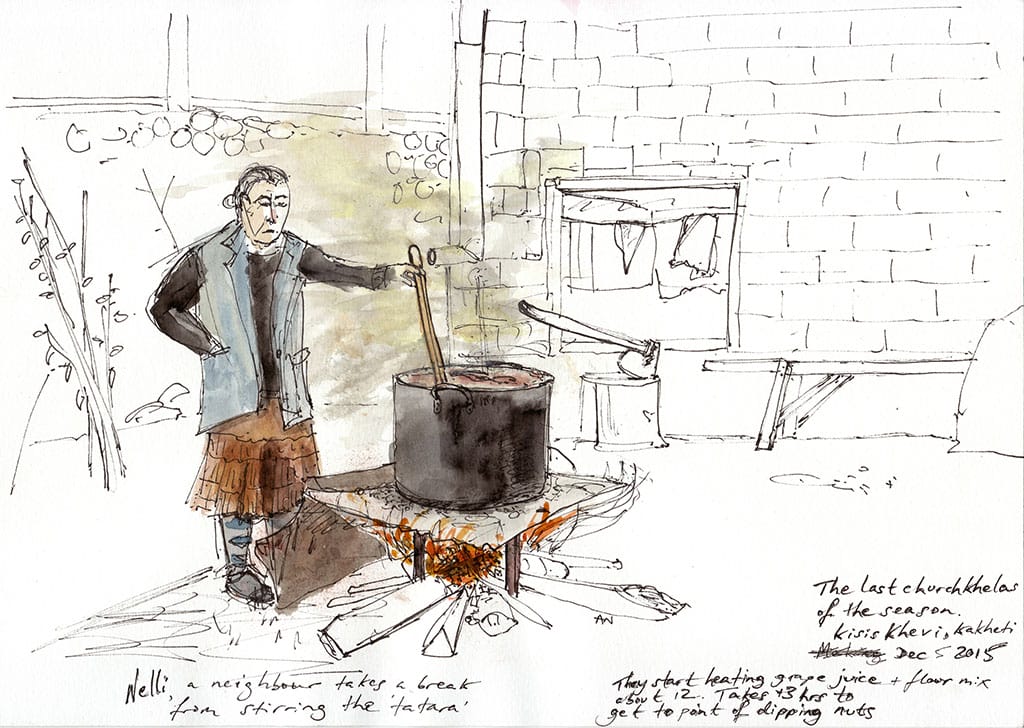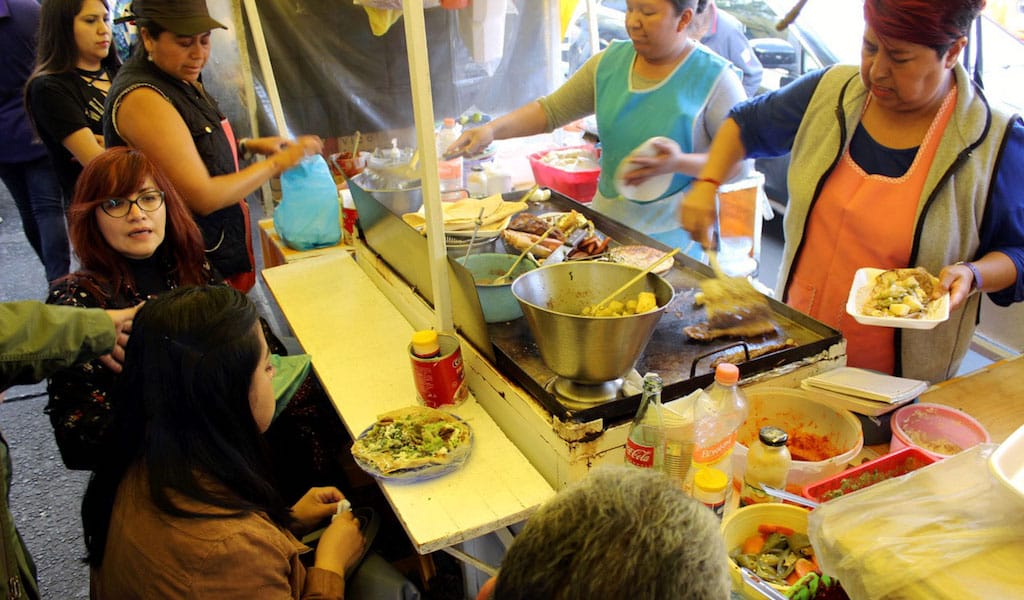Editor’s note: In the first installment of a series on food in Tokyo, part of our ever-expanding Elsewhere coverage, our correspondent writes about a century-old restaurant whose specialty is a traditional winter stew.
The weather is turning cold and Japan’s convenience stores, or konbini, have hauled out the oden service pans and positioned them next to the cashier counters. For those not familiar with oden, the sight of assorted flotsam and jetsam afloat in a clear broth and the fishy aroma impinging on their space while paying for a soft drink or chewing gum might seem puzzling. For those who love oden, though, it’s a happy reminder that there will be many ways to enjoy this hearty dish – a kind of hotpot that contains a pantry’s worth of ingredients in a light broth – as winter unfolds.

A good way to enjoy the best quality oden is at odenya restaurants, which specialize in this Japanese staple. The best reason to go to Otafuku, our favorite odenya, usually arrives with the first festival for the New Year. Each November on the Day of the Rooster (these fall every 12 days in the penultimate month, according to the zodiac calendar), we travel to Odori Shrine near the Asakusa area of Tokyo for the Tori-no-Ichi festival. It’s a lengthy subway ride from central Tokyo, made worthwhile by the promise of good fortune that comes with the special Shinto souvenirs sold at stalls lining the streets around the shrine. Afterwards, happily clutching our mementos, we head to Otafuku for oden.
Otafuku has been serving oden since 1916. This Tokyo institution is a family-run business handed down through generations. People come from all over for the beautifully crafted food, but usually it’s filled with locals out for a night of drink. The Meiji-era restaurant looks out of place surrounded by the box-like buildings on Kotodoi Dori, much like the last holdout in rampant gentrification. We walk the street amongst all the concrete, and suddenly a large lantern and garden greenery beckon to us, inviting us to enter another era. Once inside, street sounds subside, eyeglasses steam up. Dim lights recall life before fluorescents, when time was slower and so was food. Blink a few times and we are transported to what it must have been like to eat and drink in old Tokyo.
We follow a long counter with low seats as it doglegs around to the left and watch diners in animated conversation over their food and drink. Two chefs stand behind the counter fronting oden pots, ready to serve up a choice of ingredients. We’re greeted by a member of the owner’s family, who informs us there will be a wait for the counter, but we’re welcome to sit at a table in the back or in a tatami room and have the oden brought to us. It means we can’t belly up and watch the chef dive into the stew and ladle out our choices, so we opt for the counter and wait.
Now seated, we’re issued the obligatory oshibori (hot towel) so we can clean our hands and refresh ourselves while waiting for our drinks to arrive. Almost everyone begins with a beer and then moves on to hot or cold sake. Those in the know order sake cold, served directly from a wooden keg in a small cypress box imparting a woody fragrance to the sake. The waitress places a sake box perched on a small saucer in front of us and proceeds to pour sake from a pitcher until it overflows out of the box, filling the saucer as a gesture of abundance and generosity. Next up there is a little otsumami, or snack, placed quietly in front of us to accompany our drinks. Today it’s boiled tuna and onion in vinegar.
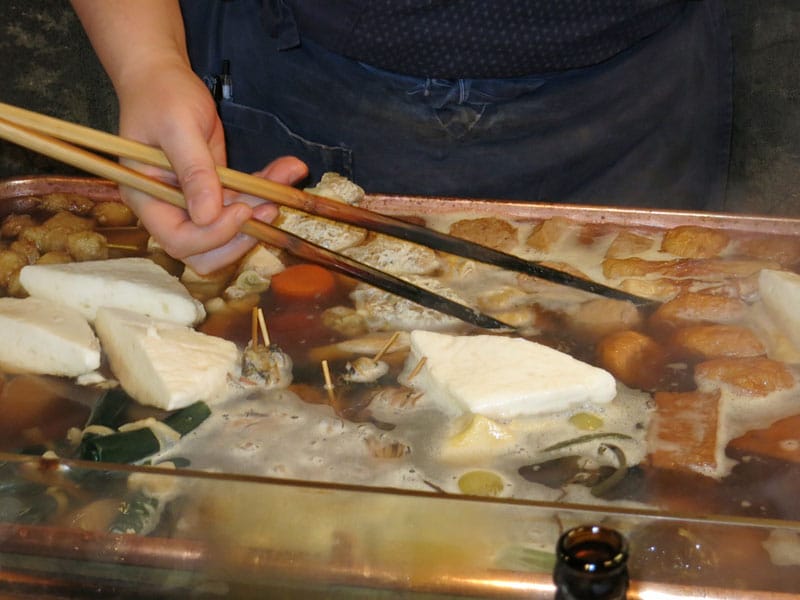
The oden master greets us with a tiny bow and a big smile and asks us to choose from a large copper vessel divided into sections. Today’s selections are written in Japanese calligraphy on slips posted on the back wall, but it’s more fun to gaze at the waiting gems and pick our favorites as we go along. We peer into the oden pot. It’s filled with a clear dashi – broth made from kelp and bonito flakes – and an assortment of oden ingredients. I inhale with anticipation and begin pointing to my favorites. There’s no need to remember the Japanese names for things because language is not necessary. The chef palms a clay soup bowl and fills it with our first three choices, then some broth and a slab of karashi mustard along the rim. We reach up to receive the bowl from him and pass it under our noses to inhale the delicate aroma.
Our chopsticks come in handy to halve the atsuage, deep-fried tofu, then swirl it in the broth and swipe it across the mustard on the way to our mouth. Next we haul up a fish cake, chikuwa, made from fish paste formed around bamboo. Rounding out our first plate is the chewy, gelatinous nub of konnyaku, made from the plant of the same name (konjac in English). We pass the plate back to the chef and point to tsukune (fish balls that remind us of gefilte fish), sliced daikon and a piece of kombu seaweed tied in a bow. The waitress watches our sake box, and when it’s nearing empty, she offers to fill it over the top again.
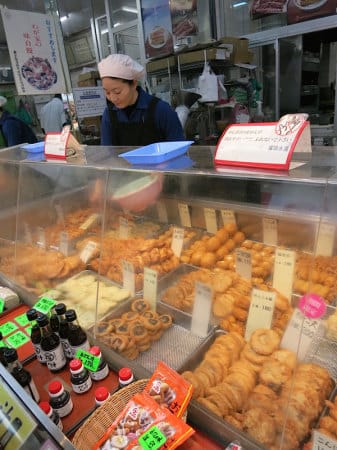 Most oden ingredients include boiled eggs, tofu products, fish cakes, vegetables, seaweed and octopus. Any credible oden pot contains at least 25 ingredients to choose from. When we’ve eaten our fill, we order rice and homemade pickles to round out the meal. And one more box of sake. Otafuku means “joyous, happy woman,” a description that seemed to fit many of the diners around us.
Most oden ingredients include boiled eggs, tofu products, fish cakes, vegetables, seaweed and octopus. Any credible oden pot contains at least 25 ingredients to choose from. When we’ve eaten our fill, we order rice and homemade pickles to round out the meal. And one more box of sake. Otafuku means “joyous, happy woman,” a description that seemed to fit many of the diners around us.
There are small stores that sell homemade oden ingredients and broth that can be assembled at home. Some places have a few tables where you can nibble from an oden pot as well. Most supermarkets sell sealed bags with takeout oden: one-pot meals for busy families. Some of the more popular oden items also show up as side dishes in bars. You can even find oden vending machines on the street.
However, if you want to experience the full array of oden, it’s best to go to an odenya for fresh, homemade ingredients and to mix and match your dinner slowly. Apart from a trip to Otafuku, there are many odenya all over Tokyo. In a pinch, there’s always the nearest 7-Eleven.
 December 1, 2021 Hanchic
December 1, 2021 Hanchic
Update: This spot is sadly no longer open.
The 2.7 square-miles of L.A.’s Koreatown […] Posted in Los Angeles December 26, 2017 Tbilisi Sketches
December 26, 2017 Tbilisi Sketches
Tbilisi stores and markets are festooned now with distinctive sausage-shaped candies […] Posted in Tbilisi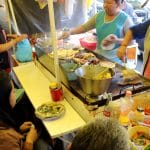 December 7, 2018 Antojitos Mexicanos Raquel
December 7, 2018 Antojitos Mexicanos Raquel
Update: This spot is sadly no longer open.
The little stall run by Raquel Ángeles and […] Posted in Mexico City
Published on December 12, 2014
Related stories
December 1, 2021
Los Angeles | By Hadley Tomicki
Los AngelesUpdate: This spot is sadly no longer open. The 2.7 square-miles of L.A.’s Koreatown holds one of the densest concentrations of restaurants, bars and nightclubs in the U.S. Hundreds of restaurants specializing in traditional Korean cooking buzz within the borders of the world’s largest such neighborhood. Here, Angelenos sample san-nakji, a plate of chopped live…
December 26, 2017
TbilisiTbilisi stores and markets are festooned now with distinctive sausage-shaped candies called churchkhela, ready for New Year celebrations and then Orthodox Christmas on January 7. They are a very traditional Georgian specialty, usually homemade from grape juice thickened with flour and nuts. But those aren’t the only ingredients you need to make churchkhela – they…
December 7, 2018
Mexico CityUpdate: This spot is sadly no longer open. The little stall run by Raquel Ángeles and her sister Evi on Balderas Avenue in Mexico City looks like any other of the tens of thousands of stands across the capital that serve millions of people every day. And yet, having eaten at hundreds of these places…















































